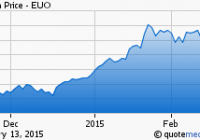Bullish Banking Earnings Drive Up These ETFs
The financial sector, which accounts for around one-fifth of the S&P 500 index and started off 2015 as an average performer, has set an upbeat tone this earnings season. Several factors including fewer litigation charges, effective cost control measures and modest improvement in core businesses has given Q2 earnings a boost and sent shares to the positive territory. The Zacks Earnings Trend also bears evidence to this burgeoning trend especially on the earnings front. Total earnings for 41.1% of the sector’s total market capitalization (reported so far) are up 11.7% on flattish revenues (down 0.1%) with beat ratios of 68.8% and 50%, respectively. The performance bettered what we saw from this group of Finance sector companies in other recent quarters. Overall, higher investment banking activity thanks to solid deals in the U.S. ranging from mergers and acquisitions to IPOs along with loan growth, sound trading business and cost containment efforts seem to be holding the key to the recent success. Let’s take a look at the big banks’ earnings which released early this week and in the last: Big Bank Earnings in Focus JPMorgan (NYSE: JPM ) reported earnings of $1.54 per share beating the Zacks Consensus Estimate of $1.44 and improving from the year-ago earnings of $1.46. JPMorgan recorded revenues of $24.5 billion, which was marginally ahead the Zacks Consensus Estimate of $24.4 billion. However, the top line compared unfavorably with the year-ago number of $25.3 billion. Wells Fargo (NYSE: WFC ) earned $1.03/share in Q2 which missed the Zacks Consensus Estimate by a penny. However, the reported figure was above the year-ago number $1.01/share. The quarter’s total revenue came in at $21.3 billion, falling short of the Zacks Consensus Estimate of $21.6 billion. But, revenues rose 1% year over year. Goldman (NYSE: GS ) earned $4.75 per share in Q2 (excluding provisions), beating the Zacks Consensus Estimate of $3.70. Net revenue declined 1% year over year to $9.1 billion but surpassed the Zacks Consensus Estimate of $8.8 billion. Morgan Stanley’s (NYSE: MS ) second-quarter adjusted earnings from continuing operations of 79 cents per share surpassed the Zacks Consensus Estimate of 73 cents but fell from the year-ago number of 89 cents. Net revenue (excluding DVA adjustments) surged 12% year over year to $9.6 billion. Moreover, it came ahead of the Zacks Consensus Estimate of $8.97 billion. Citigroup Inc.’s (NYSE: C ) adjusted earnings per share of $1.45 for the quarter outpaced the Zacks Consensus Estimate of $1.35. Further, earnings compared favorably with the year-ago figure of $1.24. Adjusted revenues of Citigroup declined 2% year over year to $19.16 billion. Including credit valuation adjustment (CVA) and debt valuation adjustment (DVA), Citigroup revenues remained relatively stable with the prior-year period at $19.47 billion. However, the revenue figure surpassed the Zacks Consensus Estimate of $19.16 billion. The true star was Bank of America Corporation (NYSE: BAC ) which turned around this season. Its second-quarter earnings of 45 cents per share outdid the Zacks Consensus Estimate of 36 cents and were way above 19 cents gains earned in the prior-year quarter. Net revenue of $22.1 billion was up 2% year over year and beat the Zacks Consensus Estimate of $21.3 billion. ETF Impact Thanks to a spate of pretty decent earnings from banks last week, the related ETFs got a boost. All the aforementioned companies have considerable exposure in funds like iShares U.S. Financial Services ETF (NYSEARCA: IYG ), iShares US Financials ETF (NYSEARCA: IYF ), PowerShares KBW Bank ETF (NYSEARCA: KBWB ), Financial Select Sector SPDR (NYSEARCA: XLF ) and Vanguard Financials ETF (NYSEARCA: VFH ). All these U.S. financial ETFs were in green and returned in the range of 1.1% to 3% in the last five trading sessions (as of July 20, 2015). Sluggish revenues were a drag on the banking earnings scorecard this season thanks to a still-low interest rate environment, which is however likely to tail off sometime later in 2015 as the Fed is preparing for an interest rate lift-off. Original Post
